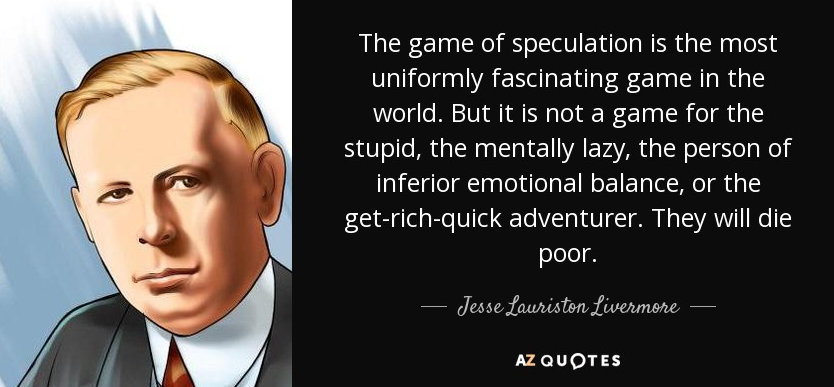Born in 1877, Jesse Livermore is perhaps the most famous trader in history. His life written by Edwin Lefèvre, titled “Reminiscences of a Stock Operator” (1923), is highly regarded as a must-read for all traders, and it deserves more than a passing recommendation. Livermore himself is also an author of a book titled “How to Trade in Stocks”(1940), was one of the greatest traders of all time.

Livermore started trading at the age of 14 from bucket shops. His tape reading skill was exceptional that these bucket shops ultimately didn’t want to do business with him. During his time in 1929, Jesse Livermore was worth $100 million, depending on the index used, in today’s dollars roughly equates to $1.5-13 billion,
Eventually, he lost his entire wealth when he broke his trading rules. The same trading rules which made him millions, caused him to lose everything when he lost control of himself. Still, there are valued lessons to be learned from Jesse Livermore’s trading experience. Herewith some of the valuable trading lesson from him.
Watch the market leaders. Look out the market leaders, the stocks that have led the charge upward in a bull market. That is where the action is and where the money is to be made. As the leaders go, so goes the entire market.
Markets are never wrong but opinions often are. The market will often go opposing to what speculators have predicted. At these times, successful speculators must abandon their predictions and tail the action of the market. Practical speculators never argue with the tape. Markets are never wrong, but opinions frequently are. According to Livermore, always remember, the market is designed to fool most of the people most of the time.
Markets are driven by humans and human nature never changes. There is nothing novel on Wall Street or in stock speculation. What has happened in the past will happen again, and again, and again. This is because human nature does not change, and it is human emotion, solidly build into human nature that always gets in the way of human intelligence. All through time, people have essentially acted the same way in the market as a result of greed, fear, ignorance, and hope. This is why the numerical formations and patterns persist on a constant basis.
Don’t be fooled by the charisma of other traders. It cost Livermore millions to learn that another dangerous enemy to a trader is his susceptibility to the influence of a magnetic personality when believably expressed by a brilliant mind.
Fear and greed are the greatest enemies. When the market goes against you, you hope that every day will be the last day – and you lose more than you should, have you not listened to hope. On the other hand, when the market goes your way, you become fearful that the next day will take away your profit and you get out – too soon. The successful trader has to fight these two deep-seated instincts.
Trading is not a get rich quick scheme. The game of speculation is the most uniformly fascinating game in the world. But it is not a game for the stupid, the mentally lazy, the person of inferior emotional balance, or the get rich-quick adventure because on the end they will die poor, according to Livermore.
Livermore was highly successful but also lost his fortune several times. He was always the first to confess when he made a mistake, and when he lost money it came down to two potential culprits, firstly the rules for trading were not fully formulated (not the case for most of his losses) and the rules were not followed. For today’s trader, these are still probably the culprits that keep profits at bay. To be profitable, we must really create a profitable trading system, and then we must obey to it in actual trading.





